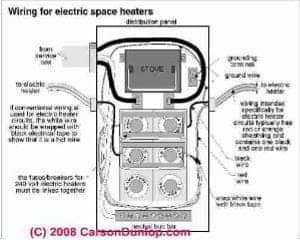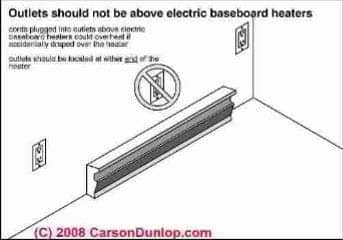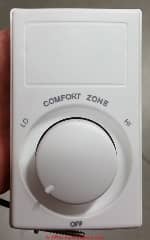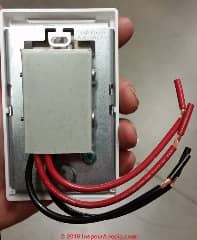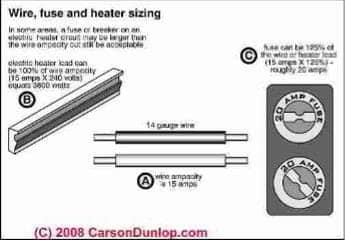 Electric Heating Baseboard Installation & Wiring Guide
Electric Heating Baseboard Installation & Wiring Guide
- POST a QUESTION or COMMENT about electric baseboard heat installation, wiring, controls, fusing, & safety
Electric baseboard heat wiring & location specifications:
Here we explain wiring sizes, ratings, fusing, and overcurrent protection for electric heaters and electric baseboards, followed by notes on the proper location for electric heating baseboards to avoid overheating or fires. Sketch at page top courtesy of Carson Dunlop.
InspectAPedia tolerates no conflicts of interest. We have no relationship with advertisers, products, or services discussed at this website.
Wiring and Overcurrent Protection for Electric Heating Systems
The wiring sizes and overcurrent protection for electric heat must be correct for fire safety, as Carson Dunlop Associates' sketch demonstrates.
[Click to enlarge any image]
Watch out: Turn off power source to the heater before attempting installation, maintenance or repairs.
Lock, tape or tag circuit breaker or fuse so that power cannot be turned on by accident.
Failure to do so could result in serious electrical shock, burns or possible death. - King Electric cited below.
Special electrical wire used for electric heating circuits is coded with red or orange plastic exterior sheathing and contains internal conductors colored black (hot) and red (hot) as well as a ground wire.
The sketch at above right handles a common electric heat wiring detail where this special electric heating wire has not been used.
Since usually our electric heaters are 240V and require two hot wires, it's common for an electrician to run conventional 12-2 NM plastic electrical cable or BX armored cable to the heater.
In order to avoid confusion during future electrical work, the white wire of the black-and-white wire pair is wrapped with black electrical tape wherever its ends are exposed for wiring connections. This tells future electricians that this is a "hot" wire, not a neutral wire.
Overcurrent protection for electric heat: Electric 240V heaters also should be powered from circuit breakers using a common trip tie or fuses that are linked together - (we don't want just one leg of the circuit to be turned off or to trip off in an emergency).
Below is a table of typical electrical circuit wire sizes and circuit protection or breaker sizes for electric heat installations, adapted from information from Knig Electric, a manufacturer of electric heaters. The original source is cited at the end of the table.
Electrical Heat Circuit Wire Size & Circuit Breaker / Fuse Size |
||||
| Total Heater Watts1 | Heater Volts | Heater Amps2 |
Circuit Wire4 | Circuit Breaker / Fuse |
| 1,440 W | 120 V | 12 A | # 14 / 2 | Single Pole 15 A |
| 1,920 W | 120 V | 16 A | # 12 / 2 | Single Pole 20 A |
| 2,880 W | 240 V | 12 A | # 14 / 2 | Double Pole 15 A |
| 3,840 W | 240 V | 16 A | # 12 / 2 | Double Pole 20 A |
| 5,760 W | 240 V | 24 A | # 10 / 2 | Double Pole 30 A |
| 7,680 W | 240 V | 32 A | # 8 / 2 | Double Pole 40 A |
Notes to the electric heat circuit sizing table above
Adapted from King Electric, ELECTRIC HEAT WIRING CIRCUIT SIZING CHART [PDF] King Electrical Manufacturing Co., cited in detail below, retrieved 2018/09/10, original source: https://www.king-electric.com/pdfs/helpful-hints-sizing-chart.pdf
Separately at ELECTRIC BASEBOARD FEET NEEDED we provide a chart showing typical number of linear feet of electric heating baseboard to heat average rooms of various sizes.
Definitions of terms such as Amps, Volts, Watts used in this article are given in detail
at DEFINITIONS of ELECTRICAL TERMS
1. Total Electric Heater Watts: this is the total wattage of all of the electric heaters connected to a single electrical circuit of the size given in the table.
That electrical load might be by just one heater or by several heaters all on the same circuit. As you'll read below, for electric heater circuits the circuit sizing is performed assuming continuous operation.
2. Heater Amps
In the table we are showing the maximum electric heater size, measured in watts or Amps, that can be safely used when connected to the electrical circuit wire size and breaker size given in the last two columns.
Heater Amps in this table is the maximum continuous electrical current loading, measured in amperes, that the electric heater will draw or create on the circuit.
Electrical circuit ampacity is the amount of electrical current, measured in amperes, that the wire conductor can carry continuously without overheating. (Overheating electrical wires can damage wire insulation and is a fire hazard).
When the electrical current drawn on the heating circuit is equal to or less than the maximum circuit load permitted by wire size and circuit breaker rating, the circuit and breaker and heater have been properly matched.
3. Maximum Circuit Load
2014 U.S. National Electrical Code Section 210.19(A)(1) Conductors Minimum Ampacity and Size
210.19(A)(1) General. Branch-circuit conductors shall have an ampacity not less than the maximum load to be served. Conductors shall be sized to carry not less than the larger of 210.19(A)(1)(a) or (b).
(a) Where a branch circuit supplies continuous loads or any combination of continuous and noncontinuous loads, the minimum branch-circuit conductor size shall have an allowable ampacity not less than the noncontinuous load plus 125 percent of the continuous load.
(b) The minimum branch-circuit conductor size shall have an allowable ampacity not less than the maximum load to be served after the application of any adjustment or correction factors.
For a dedicated electric heat circuit, the circuit ampacity must be not less than 125% of the continuous load.
- Electric Baseboards:
An electric baseboard heater producing a continuous load of 12A must be supported on a dedicated circuit with a rated capacity of 125% of 12A. 12 x 1.25 = 15A.
This heater should not be on a 15A electrical circuit shared by other receptacles, devices, or loads because such a circuit would be overloaded and thus unsafe. - Portable heaters:
No special loading calculation is performed by the installing electrician when wiring a normal residential receptacle circuit into which a portable cord-and-plug-adapter heater will be connected, because of the assumption that a portable electric heater is NOT intended for continuous use. That is, a cord and plug portable electric heater is for supplemental and temporary heat; it is not intended to serve as the primary heat source in a building.
General purpose receptacle outlets of 15- and 20-ampere ratings in dwellings are included in the general lighting-load calculations of 220.12. No additional load calculation is required for such outlets.
The U.S. NEC Article 210.19 (Branch Circuit Conductor Sizing) and Article 220.14(I), (J), and (K) (load calculations for receptacle outlets) are used together by the electrician to determine the conductor sizing and overcurrent protection required. The standard load calculation for a duplex receptacle is 180 volt-amperes.
See ELECTRICAL CODES to download copies of various electrical codes and standards.
4. Wire Type:
Assuming the electrician has selected the proper type of copper wire for the heating circuit.
Aluminum electrical wire sometimes found in older homes will be one size larger.
Watch out: while aluminum wire may already be present in some older homes, because of a serious fire hazard, we do not recommend using aluminum electrical wire for electric heat nor for other general use circuits in buildings. Details are
at ALUMINUM WIRING HAZARDS & REPAIRS - home.
Electric Baseboard Heat Installation Safety Details
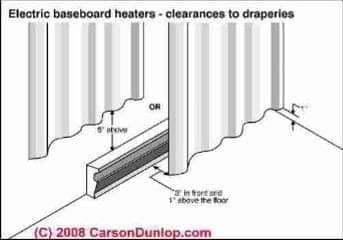
Here are some suggested safety details to avoid a fire from electric baseboard heat. Sketches courtesy of Carson Dunlop.
Fire Safety & Electric Baseboards or Other Fixed-in-Place Electric Heaters
- Curtains, Drapes, Other combustibles:
Don't locate curtains or drapes over or in front of electric heaters. Keep drapes and curtains at least 10" (some sources including CDA say 8") above electric baseboards, and at least 3" in front of them.
The reason for the 1" floor clearance is also to allow air to circulate. Circulating air both helps the heat to enter the occupied space and it also helps prevent the curtain from becoming too hot. - Electrical receptacles: As we discussed
at ELECTRICAL OUTLET, HOW TO INSTALL, we don't place electrical outlets over or too close to the ends of electric baseboard heaters. (Sketch above at right). - Thermal protection cutouts: For details about lectric baseboard heater overheating, UL Standards, & Safety Inspection using temperature monitoring equipment such as thermal scanners or thermography on electric heaters
see ELECTRIC BASEBOARD HEAT INSPECTION
Electric Heat Baseboard Installation & Wiring Manuals
Photos: a Marley MD-26 wall-mounted line-voltage thermostat used with electric baseboard heat.
[Click to enlarge any image]
Watch out: Before attempting to install your heater, verify that the power supply wires are the same voltage as the heater you are installing.
The best way to check for proper voltage is by using a voltmeter, testing between supply line 1 and 2. 240 and 120 Volt heaters are not interchangeable.
Connecting a 240 Volt heater to a 120 Volt circuit will reduce the wattage 75% making the heater feel barely warm.
Connecting a 120 Volt heater to a 240 Volt circuit will destroy the heater, could cause fire damage, personal injury or death, and, voids all warranties. - King Electric, cited below.
- Also see LINE VOLTAGE THERMOSTATS - how to wire up thermostats for electric baseboard heaters
- CADET BTF-SERIES ELECTRIC BASEBOARD THERMOSTAT MANUAL [PDF] (2017) Cadet Heaters, PO Box 1675, Vancouver WA 98668, Tel: 1-360-683-1675 Website: www.cadetheat.com
Other models of Cadet electric heater thermostats and their instructions are provided by the company at http://cadetheat.com/support/install-help - CADET ELECTRIC BASEBOARD HEAT OWNERS GUIDE [PDF] (2015) Cadet Heaters, PO Box 1675, Vancouver WA 98668, Tel: 1-360-683-1675 Website: www.cadetheat.com
- CADET UC-SERIES HEATER THERMOSTAT INSTALLATION & WIRING [PDF] Op. Cit.
Cadet Heat produces wall heaters and electric baseboard heaters. The model number is on a label or sticker beneath the grill on a wall heater or at the lower left end of a Cadet baseboard heater. - Desmond, Paul, "Clearing up Confusion over 80% vs. 100%-rated Circuit Breakers", Schneider Electric, June 12, 2014, retrieved 2018/09/09, original source: https://blog.schneider-electric.com/datacenter/power-and-cooling/2014/06/12/clearing-confusion-80-vs-100-rated-circuit-breakers/
- ELECTRIC HEATER LOCATIONS - InspectApedia.com article, includes details on clearance distances and recommended electric heat thermostat location.
- KING ELECTRIC CB-SERIES ELECTRIC BASEBOARD HEAT INSTALLATION [PDF] King Electrical Mfg. Co., 9131 10th Avenue South, Seattle, WA 98108 USA Tel: 206.762.0400 Website www.king-electric.com
- King Electric, ELECTRIC HEAT WIRING CIRCUIT SIZING CHART [PDF] King Electrical Manufacturing Co. Op. Cit., retrieved 2018/09/10, original source: https://www.king-electric.com/pdfs/helpful-hints-sizing-chart.pdf
- MARLEY 2500-SERIES ELECTRIC BASEBOARD HEAT WIRING INSTRUCTIONS [PDF] Marley Engineered Products, SPX Corporation, 470 Beauty Spot Rd. East, Bennettsville, SC 29512 USA Technical Support: 1-800-642-HEAT, retrieved 2018/07/25, original source: https://www.marleymep.com/system/files/node/file/field-file//f2500wiring.pdf
- Wiring Instructions for Marley 2500 Series Electric Basboard Heaters, [PDF] - op. cit. older version
- MARLEY D-SERIES ELECTRIC BASEBOARD WIRING [PDF], (1997) Op. Cit.
- MARLEY S1500TB S1504TB KICKSPACE HEATER WIRING INSTRUCTIONS [PDF] (2007) retrieved 2018/07/25, original source: https://www.marleymep.com/system/files/node/file/field-file//5200-2329-004.pdf
Note: This is not an electric baseboard, but rather an electrick kickspace heater blower/fan typically installed in the kick-space below a bath vanity or kitchen base cabinet. - MARLEY T-SERIES LINE VOLTAGE THERMOSTAT WIRING [PDF] Marley Electric Baseboard Heaters (intergral in the baseboard) Models TA1A Single Break, TA1TP (tamper proof), TA2A Double Break, TA2TPA (tamper proof)
- MARLEY U-SERIES FAN FORCED CEILING MOUNTED HEATERS, INSTALLATION & MAINTENANCE INSTRUCTIONS [PDF] - op. cit.
- QMARK ELECTRIC BASEBOARD HEATER INSTALLATION MANUAL [PDF] Qmark is a Marley Engineered Products Company brand; their heater instructions appear under the Marley name. Retrieved 2016/09/18, original source www.marleymep.com/sites/default/files/field-file/5200-2194-010.pdf Website: http://www.marleymep.com/
- QMARK MARLEY ELECTRIC BASEBOARD HEATERS 1800, 2500, C1800 & C2500 SERIES INSTALLATION & MAINTENANCE INSTRUCTIONS [PDF] - op. cit.
Reader Comments, Questions & Answers About The Article Above
Below you will find questions and answers previously posted on this page at its page bottom reader comment box.
Reader Q&A - also see RECOMMENDED ARTICLES & FAQs
On 2020-10-30 by (mod) - Fitting cabinets or shelves in front of heaters: fire hazard vs other damage if household items too close to heat source
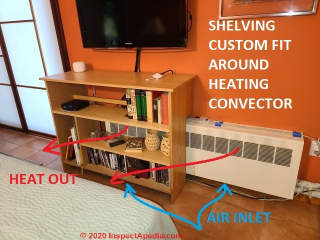 Agreed that Alison's photo shown earlier is not a fire hazard, Dan: thank you for commenting and for helping to clarify the difference between electric heat hazards and hot water heat hazards. .
Agreed that Alison's photo shown earlier is not a fire hazard, Dan: thank you for commenting and for helping to clarify the difference between electric heat hazards and hot water heat hazards. .
For clarity I also add that depending on the cabinet materials and on what's stored in the cabinet, the cabinet or its contents could be damaged by the heat from the baseboard.
Here I show oak shelving that I built to fit in a small room.
The shelving/cabinetry were cut specifically to fit around a hot water heating convector so as to permit walking space between the end of the bed and the room's wall and heating unit.
Because of limited space, a shelf that stood in front of the convector and that had any appreciable surface would have projected too far into the room, so we notched the shelving side and lower shelves to allow a large top shelf while still fitting this shelf unit around the heating convector.
Watch out: We took considerable care to both fit the cabinet to the convector and also to position shelving (and shelf contents) so as to not block air inlet at the shelving bottom nor heat outlet at the convector's outlet fins near its top.
Otherwise, a shelf filled with books or other contents may block air flow into (at its bottom) or out of the heating convector, reducting its heat output into the room and either making the room chilly or increasing heating costs unnecesssarily.
On 2020-10-30 by Dan
That looks like a hot water baseboard heater under the cabinet
Whole different thing than electric Should be OK
On 2020-05-30 by (mod) - safe to build a cabinet around heating baseboards?
Fire Safety & Electric Baseboards or Other Fixed-in-Place Electric Heaters
Curtains, Drapes, Other combustibles near an Electric Heat Source
Watch out: Don't locate curtains or drapes over or in front of electric heaters. Keep drapes and curtains at least 10" (some sources including CDA say 8") above electric baseboards, and at least 3" in front of them. The reason for the 1" floor clearance is also to allow air to circulate.
Circulating air both helps the heat to enter the occupied space and it also helps prevent the curtain from becoming too hot.
Watch out: For hot water heating baseboards, radiators, convectors close to cabinets or shelving, the issue is more one of heat damage to nearby items.
The cabinet in Alison's photo isn't curtains as noted in the article above but present other concerns
.
such as heat damage the cabinet contents. Notice that there appear to be vinyl LP records on the bottom shelf behind that open door? If that's what we're seeing, cooking your vinyl records over any sort of heating baseboard is likely to warp and ruin them!
On 2020-05-30 by Alison
Hi there. Is it safe to build cabinetry around a baseboard heater, if so, how far above the heater should the cabinetry be placed.
For example, in this image, the cabinetry is built right on top of the heater.
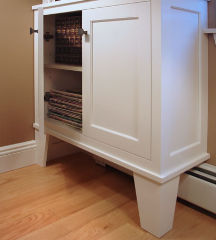
On 2018-04-21 - by (mod) - vinul siding indoors is a hazard with electric baseboard heat
With apologies that I have to speculate because I don't understand why vinyl siding material would be indoors in a building, there could be an odor and off-gassing problem of placing a hot baseboard against vinyl material.
On 2018-04-20 by Bruce wilson
Installing baseboard heater in three season room can I mount on wood floor against vinyl siding apron 350 sq ft
On 2018-04-12 - by (mod) - check for a short in electric heater wiring.
Anon
Thanks for the suggestion - that will help other readers.
While a short in any heating thermostat wiring is an important defect, for electric heat wall thermostats a short in the thermostat wiring is a particular hazard since it's at higher voltage.
However a shorted thermostat won't give insufficient heat.
It'll give no heat, or continuous heat, and -
Watch out: it risks a fire.
On 2018-04-12 by Anonymous
Make sure the Thermostat wireing isn't Corrupt,
Sometimes thie wire heat up inside the thermostat and can cause Sparking,resulting in Insufficient Heating,Check this First!
On 2017-07-13 by iqbal
Heater coils in supply air opening, found half with heating coils, while half without heating coils. engineering is requested to re check for proper spacing of heating coils in supply air opening
On 2016-02-21 - by (mod) - diagnose WESIX electric baseboard heaters
Leo:
Given the poor track record of some FPE equipment such as its circuit breakers and electrical panels, and given that your FPE controller has failed, it would make sense to have a new replacement electric baseboard heat thermostat installed.
They're pretty generic and are widely available.
Your electrician may want to take a look at your present installation, but generally it's a simple 240V circuit.
The circuit should be traced starting at the electrical panel (is each circuit breaker on?) through the individual thermostats and on to the heating elements in the baseboard heaters.
On 2016-02-21 by Leo (no email)
COMMENT:We have a mountain home built in the 70s. We have 5 WESIX electric baseboard heaters.
The two in the living/dining room areas are run by one wall thermostat (the name on that says "FPE), and have stopped working.
We mostly use our wood stove to heat this area and rarely even need the baseboard heaters, but this has been a cold winter and we need them to work.
How can we diagnose the failure....heaters vs thermostat? we're ok with buying a new thermostat but don't know anything about required voltage, wiring, etc. Is it possible the heaters went out? We're lost!
Reader comment: (May 10, 2011) Max says: said: Safety is always the #1 concern and you have effectively addressed the issue. Informative and well-focused. Great work! Regards from Max Stout
...
Continue reading at ELECTRIC HEAT BASEBOARD DIAGNOSE REPAIR or select a topic from the closely-related articles below, or see the complete ARTICLE INDEX.
Also see ELECTRICAL RECEPTACLE HEIGHT & CLEARANCES
Or see these
Articles on Electric Heat
- EFFICIENCY of 120V vs 240V EQUIPMENT
- ELECTRIC HEAT - home
- COMMON WIRE at THERMOSTATS
- CONVERT LINE to LOW VOLTAGE THERMOSTAT
- ELECTRIC BASEBOARD FEET NEEDED
- ELECTRIC BASEBOARD HEAT INSPECTION
- ELECTRIC BASEBOARD HEAT INSTALL
- ELECTRIC BASEBOARD HEAT SAFETY
- ELECTRIC HEAT DEFECTS LIST
- ELECTRIC HEAT BASEBOARD DIAGNOSE REPAIR
- ELECTRIC HEATER LOCATIONS
- ELECTRIC HEAT TYPES
- ELECTRIC HEATER RECALLS CADET & ENCORE
- NIGHT STORAGE HEATERS & HEAT SINK RADIATORS
- PORTABLE ELECTRIC HEATER FAILURES
- PORTABLE ELECTRIC HEATER SAFETY
- THERMOSTAT WIRING ELECTRIC HEAT
- ELECTRICAL POWER SWITCH FOR HEAT
- LINE VOLTAGE THERMOSTATS
Suggested citation for this web page
ELECTRIC BASEBOARD HEAT INSTALL at InspectApedia.com - online encyclopedia of building & environmental inspection, testing, diagnosis, repair, & problem prevention advice.
Or see this
INDEX to RELATED ARTICLES: ARTICLE INDEX to ELECTRIC HEAT
Or use the SEARCH BOX found below to Ask a Question or Search InspectApedia
Ask a Question or Search InspectApedia
Try the search box just below, or if you prefer, post a question or comment in the Comments box below and we will respond promptly.
Search the InspectApedia website
Note: appearance of your Comment below may be delayed: if your comment contains an image, photograph, web link, or text that looks to the software as if it might be a web link, your posting will appear after it has been approved by a moderator. Apologies for the delay.
Only one image can be added per comment but you can post as many comments, and therefore images, as you like.
You will not receive a notification when a response to your question has been posted.
Please bookmark this page to make it easy for you to check back for our response.
Our Comment Box is provided by Countable Web Productions countable.ca
Citations & References
In addition to any citations in the article above, a full list is available on request.
- In addition to citations & references found in this article, see the research citations given at the end of the related articles found at our suggested
CONTINUE READING or RECOMMENDED ARTICLES.
- Carson, Dunlop & Associates Ltd., 120 Carlton Street Suite 407, Toronto ON M5A 4K2. Tel: (416) 964-9415 1-800-268-7070 Email: info@carsondunlop.com. Alan Carson is a past president of ASHI, the American Society of Home Inspectors.
Thanks to Alan Carson and Bob Dunlop, for permission for InspectAPedia to use text excerpts from The HOME REFERENCE BOOK - the Encyclopedia of Homes and to use illustrations from The ILLUSTRATED HOME .
Carson Dunlop Associates provides extensive home inspection education and report writing material. In gratitude we provide links to tsome Carson Dunlop Associates products and services.


